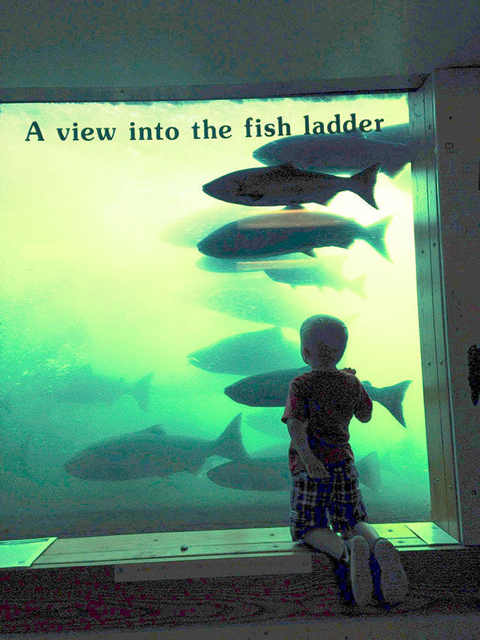forum
library
tutorial
contact

Fall Run Storms Over Bonneville;
New One-Day Record!
by Bill Rudolph
NW Fishletter, September 11, 2014
|
the film forum library tutorial contact |

|
Fall Run Storms Over Bonneville;
by Bill Rudolph
|
 With river temperatures declining slowly from their summer highs, the fall Chinook count at Bonneville Dam really began to take off. On Sept. 2, more than 21,000 fall Chinook were counted, finally showing some evidence that a record number of fish may be coming back after all. On Sept. 3, nearly 25,000 showed, nearly three times the Aug. 31 count.
With river temperatures declining slowly from their summer highs, the fall Chinook count at Bonneville Dam really began to take off. On Sept. 2, more than 21,000 fall Chinook were counted, finally showing some evidence that a record number of fish may be coming back after all. On Sept. 3, nearly 25,000 showed, nearly three times the Aug. 31 count.
Coincidently or not, the summer spill regime at the dam to aid juveniles ended with August, when spill levels went from around 70 percent to near zero.
Four days later, more than 67,000 falls showed up, and nearly the same number the day after that. Both beat the daily record for fall Chinook, set just last year on Sept. 9, when nearly 64,000 were counted.
Managers say the peak day may have well been Sept. 8, the typical half-way point in the run. But this year, it seems to be running a little late. Even with two record days in a row, the numbers may have a hard time catching up with the preseason prediction.
On Sept. 10, harvest managers said they still aren't sure where to peg the mid-point of the run this year, and have put off issuing a run update until early next week, though they feel it will come in a little below expectations. They also noted that fall tule returns to the Spring Creek Hatchery, above Bonneville Dam, were lower than expected. But they said it was likely that broodstock needs will be met at that facility.
Harvest managers had predicted that more than 1.5 million fall Chinook would return to the Columbia this year, including nearly a million upriver brights headed for the Hanford Reach, about three times the 10-year average. But by Aug. 26, when the count stood at around 40,000, only about one-third of the expected number of fish had shown up, slightly above the 10-year average.
Typically the run is about 10 percent complete by then, reaching the halfway mark by Sept. 8. Managers said on Sept. 3 that more than 300,000 had been expected to pass the dam by then, and that "passage must increase significantly in order to meet preseason forecasts."
However, with the huge numbers showing up this week, the 2014 fall Chinook count passed 435,000 fish by Sept. 10. Last year at this time, about 531,000 had shown up, and 953,000 were tallied by the end of 2013.
Lower river gillnetters had caught about 44,500 fall Chinook by Sept. 2, close to half of their expected harvest for the entire season. Sporties had landed about 27,000 fall Chinook in the Buoy 10 fishery by Sept. 1, and another 13,000 falls in the lower river above Astoria.
Managers said that lower river hatchery stocks were making up more of the Buoy 10 recreational catch than they expected--26 percent as opposed to the preseason 13-percent estimate--and were 108 percent of the preseason allotment. The fishery is constricted by ESA concerns over wild lower river tule stocks. Only about 6 percent of the commercial gillnet harvest was made up of lower river hatchery stocks, according to the latest fact sheet, but that was nearly twice preseason expectations.
Tribal catches were around 59,000 falls and 10,000 steelhead by the end of last week, reported Stuart Ellis, CRITFC harvest specialist. He said about 45,000 of the fall Chinook were upriver brights.
With a run of this expected size, tribes are allocated 30 percent of the upriver bright run, and non-Indians 15 percent.
Harvest managers heard from lower river gillnetters, who testified in support of a quick opening Thursday night before the big upriver bright run slowed down, but managers explained their concerns over the commercials going over their allotment of lower river stocks. The next scheduled openings remained in place for the evenings of Sept. 14 and 15.
Coho catches were heating up as well. By Sept. 7, sporties had caught 46,000 at Buoy 10, and 4,000 more upriver.
Since July, more than 200,000 steelhead had been tallied at the dam, a little better than expected.
Further north, the Fraser River's late summer sockeye run was coming on strong. On Sept. 1, more than 375,000 were estimated to have passed the sonar counter in the lower Fraser, and more than 5 million altogether.
Pre-season, Canadian harvest managers pegged that segment of the run at more than 12.7 million fish. On Sept. 1 they were continuing to use that estimate, but backed off earlier this week, and estimated the late summer run at 10.8 million. When the early summer (2 million) and summer components (8 million) of the Fraser run were included, the total came fairly close to the preseason median forecast of around 23 million sockeye.
The latest update from Canadian harvest managers said 99 percent of the late run is coming down the inside of Vancouver Island. In years when warm water is present off Vancouver Island, the sockeye tend to favor the inside route.
Though El Niño conditions haven't officially appeared, the sea surface temperatures off Vancouver Island are running several degrees above average.
Related Pages:
Fall Chinook Hitting at Snake-Clearwater Confluence by Rich Landers, Spokesman-Review, 9/17/14
learn more on topics covered in the film
see the video
read the script
learn the songs
discussion forum
